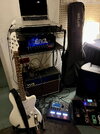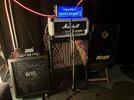Die FM9 9.0 beta ist raus, ist schon Wahnsinn was Fractal da wieder raushaut und endlich klingen die Friedmänner nach Friedmänner. Der neue Marshall Amp hat auch ein unglaubliches Spielgefühl.
Muss mich noch mit den neuen Kompressoren beschäftigen, die werden auch in den höchsten Tönen gelobt.
Allgemein hat der Sound wieder an Qualität zugelegt, wo soll das noch hinführen...
FM9 Firmware Version 9.0 public beta is now available for download: https://www.fractalaudio.com/downloads/firmware-presets/fm9/9p0/fm9_dsp_rel_9p00_public_beta_1.zip An updated version of FM9-Edit is required for use with this release...

forum.fractalaudio.com
AMP BLOCK UPDATES
NEW “
Brit 800 Studio 20” amp model based on a Marshall SC20H.
Renamed Brit Studio 20 to “Plexi Studio 20”.
Added “Plexi Brown” tone stack based on EVH’s amp with a 50K mid pot.
Updated default
Negative Feedback value for Friedman BE/HBE models. On the actual amp the negative feedback comes off the speaker jack (for some weird reason). Previously the models assumed an 8 ohm cabinet which would make the feedback effectively off the 8-ohm tap. However, the matching cabinet is 16 ohms which results in more negative feedback and a “tighter” tone, so we’re now using that as a default value as people seem to prefer that. The models were also “remastered” as a result. The
Negative Feedback control is also now available on the amp’s basic “Tone” editing page, since it is also now a control on the actual amp.
Improved triode modeling algorithms.
Improved Amp block phase inverter grid clipping model accuracy.
DRIVE BLOCK UPDATES
Improved
PI Fuzz model. The new model also allows changing the type and quantity of diodes used in the transistor feedback paths, adds a “Wicker” switch which removes the feedback capacitors and adds a “Tone” switch which allows bypassing the tone circuitry.
Added
PI Fuzz – Triangle model. This is based on a 1971 “Triangle” Big Muff PI.
Added
PI Fuzz – Ram’s Head model. This is based on mid-70’s “Ram’s Head” Big Muff PI.
Added
PI Fuzz – Russian model. This is based on a Sovtek produced “Civil War” Big Muff PI.
Added
Colortone OD model based on a Colorsound Overdriver (with added Master control).
Added
Colortone Booster model based on a Colorsound Power Booster (with added Master control).
Added
MOSFET Distortion model based on an Ibanez MT10 Mostortion.
Added
Super Fuzz model based on a Univox Superfuzz. The model also features a tone control which allows varying the frequency of the notch. Use the Bias control to simulate the “Octave” control found on some clones.
Added
Integral Pre type to the Drive block. This is based on a TC Electronics Integrated Preamp
Added
Tube Drive 5-Knob model.
Updated
DS1 Distortion model to Second Edition specs.
Improved
Tube Drive 4-Knob model. If you are using this model in a preset a soft reset of the block is recommended to load the new default values.
Reworked
Blackglass 7K model.
Added 1N5819 Schottky and Yellow LED diode models to Drive block.
REVERB BLOCK UPDATES
Improved Reverb block. Reverbs based on real spaces have more natural sounding reflections and are more immersive.
Improved
Spring Reverb algorithms. A soft reset is recommended for these types to load new default values.
Added
Vibrato-King Custom Spring type.
Added adjustable Q to Low Cut and High Cut in Reverb block.
Note: The Q only affects the response if the Slope is set to 12 dB/oct.
Changed name of “Spring Drive” to “Dwell” as this is what is commonly used on spring reverb units. Note that the Dwell control is automatically compensated. Therefore, changing the Dwell will not affect the mix unlike a hardware spring reverb, but it will make the sound more “splashy”.
Rearranged Spring Reverb menu so that most commonly used controls are on the same line.
COMPRESSOR BLOCK UPDATES
NOTE: These changes may affect the sound of your presets and can also add to CPU usage. If you use the Compressor block in your presets you should audition them accordingly.
New
Dynami-Comp algorithm: o New algorithm accurately models various nonlinearities for faithful reproduction.
Added
Knee Type to allow varying the knee shape,
Tone control (like in various clones),
Drive control for overdriving the OTA to add saturation, and new
Input/Output graph.
A low-CPU version is available with the
Econo-Dyno-Comp type.
New “
VCA Bus Compressor” algorithm (replaces “Studio FB Compressor”) o Based on a VCA feedback design (e.g., SSL Bus Compressor).
Dynamic time constants. Extremely fast attack times are achievable as the actual attack time is always less than the programmed time (decreases dynamically). Removed
Auto Att/Rel as it is not applicable.
New
Optical Compressor Algorithm: o Based on classic optical rackmount compressors. The smooth attack and release characteristics make it ideal for vocals and acoustic instrument sources.
Times are “doubly dynamic”. The times are dynamic due to the feedback topology of the compressor and the attack and release times of the photocell are also dynamic. The Attack and Release Time controls set the nominal times of the photocell. However, the times will vary with the program level.
Due to the design of these compressors the minimum compression ratio is 4:1. Any settings below 4.0 will be clamped at 4:1.
Whereas hardware optical compressors typically have a fixed compression ratio (usually about 4:1) and a limiting option, this algorithm allows adjusting the ratio from 4:1 to (nearly) infinite.
Rather than input/output gain controls the algorithm allows adjusting the threshold instead which requires less fiddling with the makeup gain.
The Emphasis control replicates the internal “Limiter Response” adjustment. This control may be on the front panel of some clones and the operation may be reversed depending upon the manufacturer. The Emphasis Frequency control allows shifting the frequency range of the curve.
The “Drive” control allows overdriving the output stage for added distortion.
New
JFET Compressor algorithm: o Based on classic JFET rackmount compressors. Perfect for fattening up your sound and adding grit. Works well as a “finishing” compressor at the end of a chain (usually before time-based effects). Also great for vocals, bass and drums
Dynamic time constants. The Attack and Release times are the “native” times of the detector. The actual Attack and Release times will be much shorter (about 5 times). The native range of Attack Time for an 1176 is 0.1 ms to 5.5 ms. The Release Time range is 59 ms to 1.1 s.
Due to the design of these compressors the minimum compression ratio is 4:1. Any settings below 4.0 will be clamped at 4:1.
Due to the very fast attack times these types of compressors will distort. This is often used for effect. Low frequencies are distorted more.
The “Drive” control allows overdriving the output stage for added distortion.
Unlike the actual hardware the algorithm’s threshold is variable so instead of varying the input and output gains we give you a more convenient method (and Automatic Makeup Gain).
New
JFET Pedal Algorithm o Based on pedals with a JFET as the shunt resistor in a non-inverting op-amp configuration.
Replaces the JFET Sustainer type.
New
Rockguy Compressor Type: o Similar to the JFET Pedal but with dynamic release time and several other enhancements.
New
Tube Compressor Algorithm (now called “Vari-Mu Tube Compressor”): o Based on a tube compressor using “remote-cutoff” tubes for gain control. This compressor has big, swoopy compression curves and a warm tone making it useful for adding “glue” to a track or mix.
Features dynamic attack times.
The actual compression ratio is somewhat nebulous due to the nature of the circuit but, in general, the minimum ratio is about 2:1 and the maximum ratio is about 20:1. The Threshold and Compression controls interact. The graph assists with adjusting the controls.
The “Drive” control allows overdriving the output stage for added distortion.
PHASER BLOCK UPDATES
New
Vibe algorithm in Phaser block. The default values have changed for the Vibe models and existing presets are automatically updated to the new defaults. If you have edited the default values, you may wish to audition your presets accordingly.
Added “LFO Mode” to the Phaser block. When set to UNIVIBE the amplitude of the LFO is roughly proportional to the LFO Rate. When set to NORMAL the amplitude is constant. NORMAL allows deeper phasing at slow rates than would be possible with an actual Univibe.
Added Low Cut and High Cut controls to Phaser block for the wet path.
Added
Modern Vibe model to Phaser block, based on a classic UniVibe but with modern input buffer and LFO.
Changed “Exponent” to “VCR Shape” as this more accurately describes the control function.




